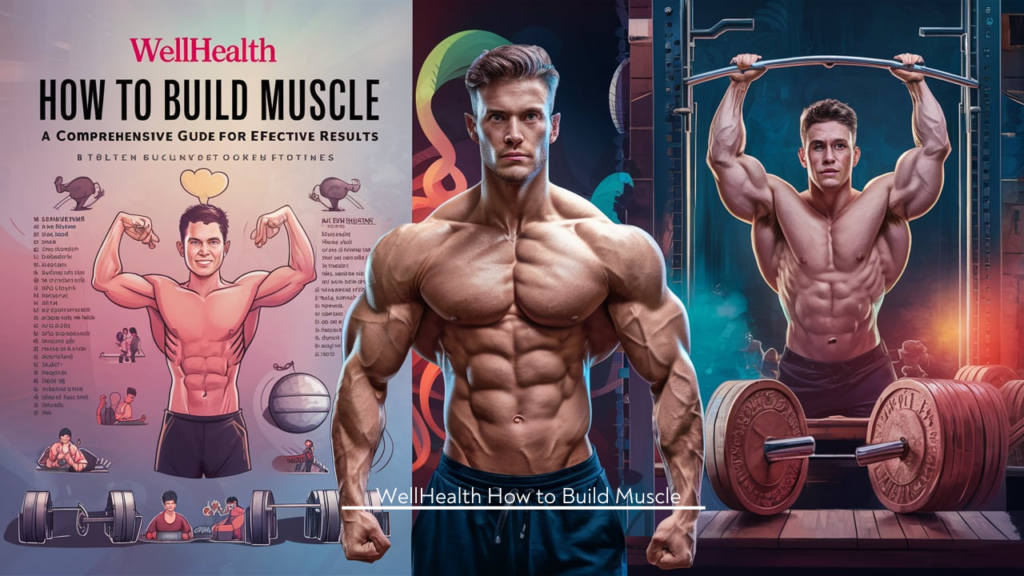To build muscle effectively, you need a balanced approach that combines training, nutrition, and recovery. With the WellHealth How to Build Muscle Tag, you’ll discover essential strategies to optimize your workouts, fine-tune your diet, and enhance your recovery process. This guide offers a streamlined approach to achieving your muscle-building goals efficiently and sustainably using the WellHealth How to Build Muscle Tag techniques.
Understanding wellhealth how to build muscle tag
The Science Behind Muscle Growth
Muscle increase, or hypertrophy, happens whilst muscle fibers are subjected to stress and expand microscopic tears. Here’s an in-depth examine the approaches concerned:
- Mechanical Tension: Lifting weights or performing resistance sporting events creates mechanical tension to your muscle tissues. This tension is vital for starting up muscle growth. The force exerted at the muscular tissues in the course of these sports stimulates organic processes that cause expanded muscle length and electricity. Source: Journal of Applied Physiology
- Muscle Damage: Exercise-prompted pressure causes tiny tears in muscle fibers. The body responds to these micro-accidents by repairing and reinforcing the muscle fibers, making them stronger and larger over the years. This restore process involves synthesizing new proteins to build muscle mass. Source: American Journal of Physiology
- Metabolic Stress: During intense exercise, metabolites (substances produced at some stage in metabolism) accumulate inside the muscle. This buildup creates a traumatic surroundings that promotes muscle growth through signaling the body to evolve and boom muscle length. Source: Exercise and Sport Sciences Reviews
Understanding those ideas allows in creating a more effective muscle-building plan the use of WellHealth How to Build Muscle Tag techniques. Imposing sports that set off mechanical anxiety, carefully handling exercise intensity, and allowing for recuperation can optimize muscle growth with the WellHealth How to Build Muscle Tag approach.
Types of Muscle Growth
Muscle increase may be classified into two number one kinds, every contributing differently to ordinary muscle improvement:
- Myofibrillar Hypertrophy: This sort of boom increases the size and electricity of muscle fibers themselves. It enhances muscle density and strength, leading to stepped forward overall performance in electricity-based activities. Physical games that target lifting heavy weights with fewer repetitions commonly stimulate myofibrillar hypertrophy, as highlighted by the WellHealth How to Build Muscle Tag.
- . Sarcoplasmic Hypertrophy: This entails growth inside the muscle’s electricity storage, such as glycogen. It improves muscle persistence and overall potential. Workouts designed to increase muscular endurance, which includes those related to higher repetitions and lighter weights, basically promote sarcoplasmic hypertrophy.
A balanced exercising software needs to incorporate elements of each myofibrillar and sarcoplasmic hypertrophy, as distinct in WellHealth How to Build Muscle Tag guide. This guarantees complete muscle development, addressing both power and endurance.
Nutritional Strategies for Optimal Muscle Building
Crucial Macronutrients for Muscle Growth
To build muscle successfully, attention on three key macronutrients, each gambling a essential function in muscle improvement:
- Protein: Essential for repairing and building muscle. Aim for 1.6 to 2.2 grams of protein per kilogram of body weight each day. Terrific assets encompass chicken, fish, eggs, and legumes. Protein offers the amino acids needed for muscle restore and growth, assisting the synthesis of latest muscular tissues.
- Carbohydrates: Provide the necessary strength for workouts and recuperation. Choose complex carbohydrates like complete grains, end result, and greens for sustained electricity release. Carbs top off glycogen stores in muscular tissues, which is vital for recuperation and sustaining performance at some point of excessive schooling.
- Fats: Aid hormone production, which includes hormones crucial for muscle increase like testosterone. Include sources of wholesome fat, consisting of avocados, nuts, and olive oil, for your food regimen. Fats also aid inside the absorption of fats-soluble nutrients and contribute to basic fitness.
Timing Your Meals
Strategic meal timing can appreciably impact muscle growth and recuperation:
- Pre-Exercise: Eat a balanced meal rich in protein and carbohydrates approximately 1-2 hours before your exercising. This provides the essential fuel for overall performance and initiates the healing procedure. For example, a meal of grilled chicken with brown rice and vegetables can improve strength levels and decorate workout effectiveness.
- Post-Exercise: Eat a meal or snack high in protein and carbohydrates within 30-60 mins after exercising. This allows restore and build muscle mass via replenishing glycogen stores and offering amino acids for muscle restore. Options consist of a protein shake with a banana or a turkey sandwich on whole-grain bread.
Hydration
Proper hydration is vital for muscle function and recuperation. Purposely drink 8-10 glasses of water each day to live hydrated. Increase your water intake around exercise times to make amends for fluid loss via sweat. Staying hydrated helps average bodily functions, together with nutrient delivery and muscle contraction.

Designing an Effective Exercise Program
Setting Up Your Training Plan
An powerful muscle-constructing program carries numerous sorts of physical activities and progression strategies:
- Compound Exercises: Target a couple of muscle agencies concurrently, enhancing general muscle boom. Examples encompass squats, deadlifts, and bench presses. These sporting activities promote the release of boom hormones and stimulate massive muscle businesses, contributing to extra muscular tissues and strength.
- Isolation Exercises: Concentrate on precise muscle mass, making an allowance for focused improvement. As an instance, bicep curls and tricep extensions isolate the arm muscular tissues, assisting to refine and define particular regions. These physical games supplement compound actions through addressing smaller muscle corporations.
- Progressive Overload: Gradually boom the burden or resistance used in sporting events to constantly task your muscle tissues and promot growth. This principle includes systematically increasing the depth of your workout routines to make certain ongoing progress and edition.
Sample Workout Split
A balanced exercising recurring may consist of:
- Day 1: Chest and Triceps – Perform physical games like bench presses and tricep dips to goal the upper body.
- Day 2: Back and Biceps – Include sports such as pull-ups and bicep curls to strengthen the lower back and arm muscular tissues.
- Day 3: Rest or Mild Cardio – Have interaction in activities like taking walks or biking to sell recuperation and cardiovascular health.
- Day 4: Legs and Abs – Focus on decreased body sports such as squats and abdominal sports for leg power and core stability.
- Day 5: Shoulders and Arms – Carry out shoulder presses and arm curls to build shoulder and arm muscle groups.
- Day 6: Rest or Active Recuperation – Participate in low-intensity activities or stretching to useful resource muscle healing.
- Day 7: Full Relaxation – Permit whole relaxation to recover and put together for the following cycle of exercises.
Importance of Form and Technique
Maintaining the right shape at some stage in physical activities is crucial for stopping accidents and maximizing effectiveness. Prioritize accurate methods to make sure that you are focused on the supposed muscular tissues and reduce the threat of strain. Use mirrors, video feedback, or are looking for steerage from a teacher to refine your shape.

Advanced Strategies and Overcoming Plateaus
Dealing with Plateaus
Hitting a plateau can preclude development, but numerous techniques can assist overcome it:
- Changing Your Routine: Introduce new sporting events or variations to task your muscular tissues otherwise. This could include altering the order of sporting activities or incorporating new training modalities.
- Adjusting Volume and Intensity: Increase the variety of sets, repetitions, or weights used to push through the plateau. For instance, adding an extra set or growing weights progressively can stimulate continued growth.
Incorporating Advanced Techniques
- Drop Sets: Perform a workout until muscle failure, then reduce the burden and keep. This approach will increase intensity and may lead to improved muscle boom by extending the time beneath tension. Source: Journal of Strength and Conditioning Research
- Supersets: Integrate two sporting events with minimum relaxation in between to reinforce the exercising’s depth and performance. As an example, performing a fixed bench press accompanied at once by a hard and fast push-up objectives the chest muscles intensively.
The Importance of Recovery and Rest
Why Recovery Matters
Recovery is crucial because it’s all through this phase that muscle tissue repair and grow. Without good enough rest, you risk overtraining, which could cause injuries and restrict progress. Healing permits the body to replenish electricity shops, repair muscle fibers, and adapt to training stimuli.
Strategies for Effective Recovery
- Rest Days: Ensure you’ve scheduled relaxation days to permit muscle mass to restore and grow. This facilitates in stopping burnout and retaining lengthy-term progress.
- Sleep: Intention for 7-9 hours of satisfactory sleep per night time to assist muscle restoration and ordinary health. Correct sleep hygiene, which includes retaining a constant sleep agenda and developing a restful environment, can beautify restoration. Source: Sleep Medicine Reviews
- Active Recovery: Interact in low-intensity activities like stretching, yoga, or light swimming on relaxation days to sell blood waft and decrease muscle discomfort.
Coping with Muscle Discomfort
Muscle soreness after exercises is everyday, but managing it’s far crucial for powerful restoration. Techniques like foam rolling, mild stretching, and applying warmness or bloodless packs can alleviate pain and aid restoration.
Conclusion
Building muscle requires a balanced technique that consists of effective schooling, proper vitamins, and ok restoration. By understanding the technology behind muscle increase, following a well-established exercising plan using WellHealth How to Build Muscle Tag, and enforcing advanced strategies, you can gain your muscle-building goals efficiently. wellhealth how to build muscle tag comprehensive manual affords actionable insights and strategies to guide you through each step of your muscle-building adventure.




